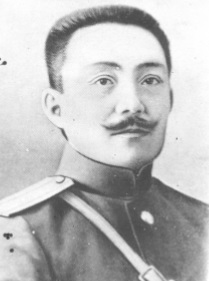
SEIDALIN Andrey Petrovich (present name and pham. Abubekr Mukashevich KRYM-GIRAY SEIDALIN) /1881 – 1954/ – military veterinarian, collegiate assessor, nobleman, one of the organizers of the State veterinary service of Kazakhstan (1920-1922), responsible employee
of the Kaznarkomzeme State University. A. P. Seidalin was born in Kostanay, Kazakh by nationality.
After graduating from the Kazan Veterinary Institute in 1904, on October 10 (23), 1905, he decided to serve as a district veterinarian of the Kuban region. Some time later, he joined the military service as a veterinarian in the 8th East Siberian Rifle Division, where, for years of service, on November 24 (December 7), 1907, he was promoted from collegiate secretaries to titular advisers, and on February 27, 1911, according to the old style, A. P. Seidalin was promoted from titular advisers to collegiate assessors.
On December 25 (January 7), 1913, in the name of the Sovereign Emperor (Tsar Nicholas II), military veterinarian of the reserve cavalry division A. P. Seidalin was awarded the Order of St. Stanislaus of the 3rd degree.
In September 1920, the government of Kazakhstan appointed A. P. Seidalin as the head of the Central Department of Kaznarkomzem and entrusted him at the same time with the leadership of the Veterinary Unit (HF) of Kazkraivoenkom.
On October 21, 1920, A. P. Seidalin put forward the idea of publishing the periodical journal of the Central Department of the Kaznarkomzem “Veterinary Bulletins”, on this occasion a circular letter was sent to all veterinary institutions with detailed requirements for the sent manuscripts of articles. Special attention was paid in the circular to such a common animal species in Kazakhstan as the camel, which, according to the author, had not been sufficiently studied by that time.
On October 25, 1920, A. P. Seidalin submitted to the People’s Commissariat of Agriculture of the KASSR a proposal to create an independent commissariat of veterinary and animal husbandry in Kazakhstan, since the tasks of agriculture on the one hand and veterinary and animal husbandry on the other hand have few common problems and tasks.
In the Regulations on the Veterinary Department, signed by A. P. Seidalin at the end of 1920, it was first proposed to create an Institute of Experimental Veterinary Medicine at the Central Veterinary Department of Kaznarkomzem.
Most likely, at the beginning of 1921, A. P. Seidalin, for some reason, no longer worked as the head of the Central Department, and after leaving for the Bukeevskaya province, he entered Urda (now Narimanov, Astrakhan region of the Russian Federation) as the head of the registry office sub-department.
On May 7, 1921, in accordance with the order of the Kaznarkomzem No. 72, A.P. Seidalin was appointed deputy head of the newly organized GUVZH. In connection with which, in early June 1921, he was forced to arrive from Urda to Orenburg to his new place of work.
On January 10, 1922, at the initiative of A. P. Seidalin, an appeal to American veterinarians for financial assistance was prepared at the Technical Meeting of the State Medical Institution Kaznarkomzem. The appeal spoke about the dreary life of veterinary workers in Kazakhstan, “who do not receive salaries, rations for several months, do not have clothes and shoes, in some places forced to beg, and the inability (to carry out) medical activities due to the lack of medicines and other types of veterinary supplies” (the document was apparently transmitted through the American the administration of assistance / ARA/, the branch of which was located at that time directly in Orenburg).
In his theses of March 8, 1922, A. P. Seidalin strongly demanded from higher authorities to equip all the VBLs available in Kazakhstan with the necessary equipment, technical personnel and financial resources, while he stressed that “not a single pound of medicinal substances” had been received from Moscow in 1921.
In all likelihood, from March to August 1922, A. P. Seidalin worked as the head of the State Budgetary Institution Kaznarkomzem, and then continued his work as the head of the High Commission Kazvoenkom. On his initiative, the Orenburg Military Veterinary Laboratory was organized at the Kazvoenkom High School.
In the late 20s and early 30s of the twentieth century, A. P. Seidalin was repeatedly a member of the Boards of the Kaznarkompros and Kaznarkomzem, and was also a member of the Plenum and the Revkom of the Union of Medical Labor. He was entrusted with responsible tasks of the state for the training of young specialists for the needs of agriculture and their distribution after graduation to the farms of the republic, based on the experience of the Agricultural Academy and the Agricultural Institute.
On January 1, 1935, A. P. Seidalin was enrolled as a State Veterinary Inspector for equine diseases in the staff of the Alma-Ata medical veterinary plant.
On March 9, 1936, in accordance with Order No. 267, he was appointed senior veterinarian for epizootics at Kaznarkomzeme.
He was persecuted for his high professionalism and integrity in his work. So, in September 1936, the leadership of the Higher Education Institution of Kaznarkomzem A. P. Seidalin was asked to revise the control figures for epizootics for 1937 in the direction of decreasing indicators, but he did not accept this deal and was reprimanded.
During the period of leadership of the Veterinary service of Kazakhstan, A. P. Seidalin contributed in every possible way to the work of the CCVBL (later KazNIVI) [1, 2, 3, 4, 5].
USED LITERATURE:
- CGA RK. F. 74. Op. 6. D. 1. L. 10-10 ob.
- CGA RK. F. 74. Op. 8. D. 2. L. 8-8 ob.
- CGA RK. F. 74. Op. 8. D. 7. L. 59.
- CGA RK. F. 74. Op. 8. D. 501. L. 93.
- Veterinariya Kazahstana // Pod red. A.R. Abisheva. – Alma- Ata, 1970. – S. 48-51.